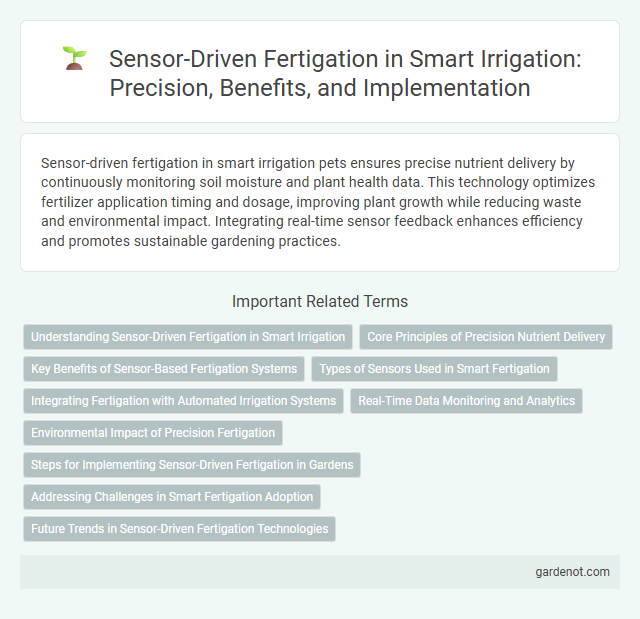Sensor-driven fertigation in smart irrigation pets ensures precise nutrient delivery by continuously monitoring soil moisture and plant health data. This technology optimizes fertilizer application timing and dosage, improving plant growth while reducing waste and environmental impact. Integrating real-time sensor feedback enhances efficiency and promotes sustainable gardening practices.
Understanding Sensor-Driven Fertigation in Smart Irrigation
Sensor-driven fertigation in smart irrigation integrates soil moisture and nutrient sensors to precisely regulate water and fertilizer application. This technology optimizes crop growth by delivering nutrients based on real-time soil conditions, reducing waste and enhancing resource efficiency. Data from sensors enables targeted fertigation schedules, improving plant health and increasing agricultural productivity.
Core Principles of Precision Nutrient Delivery
Sensor-driven fertigation enhances smart irrigation by precisely monitoring soil nutrient levels and plant requirements in real-time, enabling targeted delivery of water and fertilizers. Core principles of precision nutrient delivery include site-specific application, optimizing nutrient use efficiency, and minimizing environmental impact by reducing leaching and runoff. Integration of soil moisture sensors, nutrient sensors, and automated dosing systems ensures dynamic adjustment based on crop growth stages and environmental conditions.
Key Benefits of Sensor-Based Fertigation Systems
Sensor-based fertigation systems optimize nutrient delivery by continuously monitoring soil moisture, pH, and nutrient levels, ensuring precise application tailored to crop needs. These systems enhance water and fertilizer efficiency, reducing waste and minimizing environmental impact while boosting crop yield and quality. Real-time data enables proactive adjustments, improving plant health and supporting sustainable agricultural practices.
Types of Sensors Used in Smart Fertigation
Soil moisture sensors, such as capacitive and time-domain reflectometry (TDR) sensors, are essential for monitoring water content and optimizing nutrient delivery in smart fertigation systems. Electrical conductivity (EC) sensors measure the nutrient concentration in the soil solution, enabling precise adjustment of fertilizer dosage. Additionally, pH sensors regulate the acidity levels of the irrigation water, ensuring optimal nutrient availability and preventing plant stress.
Integrating Fertigation with Automated Irrigation Systems
Sensor-driven fertigation enhances crop growth by precisely delivering nutrients through automated irrigation systems, ensuring optimal water and fertilizer use. Integrating soil moisture sensors and nutrient sensors allows real-time adjustments to fertigation schedules, reducing waste and improving plant health. This system promotes sustainable agriculture by maximizing resource efficiency and minimizing environmental impact.
Real-Time Data Monitoring and Analytics
Sensor-driven fertigation integrates real-time data monitoring and analytics to optimize nutrient delivery based on soil moisture, temperature, and crop growth stages. Advanced sensors continuously collect precise environmental and plant health metrics, enabling automated adjustments to fertigation schedules for enhanced efficiency. This data-driven approach reduces nutrient wastage, improves crop yield, and supports sustainable water and fertilizer use.
Environmental Impact of Precision Fertigation
Sensor-driven fertigation significantly reduces nutrient runoff by delivering precise amounts of fertilizers tailored to real-time soil and plant needs, enhancing environmental sustainability. This precision decreases water contamination risks and minimizes greenhouse gas emissions associated with excessive fertilizer use. Implementing sensor-based systems promotes efficient resource use and supports sustainable agricultural practices that protect ecosystems.
Steps for Implementing Sensor-Driven Fertigation in Gardens
Implementing sensor-driven fertigation in gardens involves installing soil moisture and nutrient sensors at root zones to continuously monitor real-time conditions. Data from these sensors is transmitted to an automated fertigation system, which adjusts the delivery of water and fertilizers precisely based on plant needs. Regular calibration of sensors and integration with weather data optimize resource efficiency and promote healthier plant growth.
Addressing Challenges in Smart Fertigation Adoption
Sensor-driven fertigation optimizes nutrient delivery by integrating real-time soil moisture and nutrient sensors with automated irrigation systems, enhancing crop yield and resource efficiency. Challenges in smart fertigation adoption include high initial costs, sensor calibration complexity, and data integration with existing farm management systems, which require targeted solutions for scalability. Addressing these issues through cost reduction, user-friendly interfaces, and standardized protocols can accelerate widespread implementation in precision agriculture.
Future Trends in Sensor-Driven Fertigation Technologies
Emerging innovations in sensor-driven fertigation emphasize real-time nutrient monitoring and automated adjustment systems, significantly improving water and fertilizer use efficiency. Advanced IoT-enabled sensors integrated with AI analytics enable precise nutrient delivery tailored to crop growth stages and environmental conditions. Future trends point to increased adoption of wireless sensor networks and machine learning algorithms, which optimize fertigation schedules, reduce waste, and enhance sustainable agricultural productivity.
Sensor-driven fertigation Infographic

 gardenot.com
gardenot.com